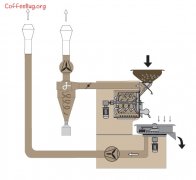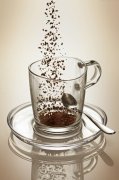The basic chemical reaction of coffee roasting process
Many thermal and chemical reactions take place during baking: decarbonation, dehydration of quinic acid, subdivision, isomerization, polymerization, and complex sugar reactions (caramelization). The main components of the thermal reaction are monosaccharides and sucrose, chlorogenic acid, free amino acids, and fenugreek amide. Both aravinose and calactose in the polysaccharides were transferred, and the basic vulcanization included hydroxy acid decomposition. Carbohydrates are polymerized and decomposed at the same time, and depending on the degree of baking, 20-30% of the polysaccharides are broken down, releasing thermally unstable monosaccharides.
Sucrose: a disaccharide consisting of D-glucose and D-fructosyl.
Sucrose is the main sugar in coffee. The melting point of pure crystalline sucrose is 320,392 degrees Fahrenheit (160,200 degrees Celsius), and the accepted melting point is 370 degrees Fahrenheit (187.8 degrees Celsius). The melting point of degraded dried sucrose can be as low as 194 degrees Fahrenheit (90 degrees Celsius), and as it is dehydrated and concentrated, the sugar begins to split into glycoside conjugates. Between 338 and 392 degrees Fahrenheit (170 and 200 degrees Celsius), the caramelization reaction begins. It is at this point that water and carbon dioxide burst, and the resulting outgassing causes an explosion. These are chemical reactions that occur at about 356 degrees Fahrenheit (180 degrees Celsius), which is an exothermic reaction. It is very important that once the caramelization begins, the coffee should not release heat (heat), otherwise the coffee cup will taste like "baked". One possible explanation is that the release of heat from heated coffee beans breaks the long polymer chain and causes the broken long chain to connect to other ingredients. Sucrose and later converted ingredients, or caramelization, are determined by the presence of water, ammonia, and proteinatious substances. Heavy baking shows a higher degree of caramelization than light baking. The degree of caramelization is a good measure of baking with high resolution.
Cellulose: anhydrous long linear polymer (A Long Linear Polymer of Anhydroglucose Units)
Cellulose is the main fiber in the cell wall of coffee. This is local order (crystallization) and local disorder (amorphous / amorphous). The amorphous region is easily affected and easy to react, but the crystal region is closely packed and hydrogen-bonded, which is almost completely unaffected. Natural cellulose, or cellulose I, is converted into isomers cellulose III and cellulose IV when heated. The structure of coffee is a well-developed matrix, which improves the consistency of quality and contributes to the uniform spread of heat during baking. Cellulose exists in coffee in the form of embedded in lignocellulose (an amorphous matrix containing hemicellulose and cellulose-containing lignin), which form matrix unit walls (cell walls). Hemicellulase (hemicellusloses) is a polysaccharide composed of bifurcated sugar and uronic acid. Lignin is particularly noteworthy because it is a highly polymerized aromatic substance. When the distribution temperature exceeds 446 degrees Fahrenheit (230 degrees Celsius) and the surface temperature of beans exceeds 536 degrees Fahrenheit (280 degrees Celsius), the cell wall is severely damaged. The actual temperature will change according to other factors. The second explosion associated with deep baking is the rupture of this matrix, which may be accompanied by volatilization of lignin and other aromatic hydrocarbons. Under controlled roasting conditions, the ambient temperature of beans should never exceed 536 degrees Fahrenheit (280 degrees Celsius). A wider safety line should limit the maximum ambient temperature to 520 degrees Fahrenheit (271.1 degrees Celsius). These temperature limits can minimize damage to the cell matrix, increase the complexity of performance in the cup, increase roasting yield and product shelf life cycle.
Fenugreek amide (Trigonelline): a nitrogen group (A Nitrogenous Base) found in coffee
Fenugreek amide is 100% soluble in water, so it will eventually appear in the cup. Fenugreek amide is the most important ingredient that produces excessive bitterness. About 85% of fenugreek amide degrades when the bean temperature is 445 degrees Fahrenheit (229.4 degrees Celsius). When the bean temperature is at this point, the beans are baked at a medium depth. There is more fenugreek amide for lighter baking, so it tastes bitter, but less caramelized sugar at this temperature. Caramelized sugar is less sweet in the cup than uncaramelized sugar, so when baked properly, the two ingredients can set off each other to make the taste better. The melting point of pure crystalline fenugreek amide is 424 degrees Fahrenheit (217.8 degrees Celsius), and fenugreek amide begins to degrade at about 378degrees Fahrenheit (192.2 degrees Celsius). The degradation of fenugreek amide is one of the key control indicators to determine the optimal reaction ratio.
Quinic acid: a member of the carboxylic acid group
The melting of pure crystals of quinic acid begins at 325 degrees Fahrenheit (162.8 degrees Celsius), much lower than the temperature in the baking environment. Quinic acid is water-soluble, slightly sour (not the bad taste of fermented beans) and sharp, giving more characteristics and complexity to the performance in the cup. Surprisingly, it also brings a clean it adds cleanness to the finish of the cup as well to the cup-tested aftertaste. It is a stable compound at baking temperature.
Nicotinic acid: a member of the carboxylic acid group
The melting of pure crystals of nicotinic acid begins at 457 degrees Fahrenheit (236.1 degrees Celsius). Natural nicotinic acid is bound to the structure of polysaccharide cellulose. Nicotinic acid is derived from soluble form during baking. Regardless of the degree of baking, high-grade niacin is always associated with good cup performance. Because it is 100% soluble, it will eventually appear in the cup. Niacin contributes to good flavor acidity and clean aftertaste (clean finish). Its derivative rate is a key control marker that can be used to determine the temperature of the optimal reaction rate, as well as the chemical transmission rate (chemistry propagation rates). In addition, the interaction of melted nicotinic acid with other components can significantly increase the brightness of deep-roasted coffee (shown in the cup).
Ambient temperature
The temperature of the baking environment determines the occurrence of certain types of chemical reactions. There is a temperature window, (baking in this window) will produce a good flavor reaction and produce the ideal performance in the cup. The temperature beyond this window will have a negative effect on the performance of the classic cup. Even if the temperature value is in the window, different temperatures will still change the characteristics of the cup, giving the baker space to develop a personal style or a desired style, or to tame the personality of a coarse mineral in a certain kind of coffee. at the same time, the relevant quality can still be controlled to the best.
System energy
At any given ambient temperature, the amount of energy (BTU) and the transmission efficiency of the baking system will determine the rate at which specific chemical changes occur. If the energy and transfer rate are high, the reaction will be faster. The reaction rate also has a window in which the quality of the cup can be optimized. This is called the optimal reaction rate, or BRR for short.
Optimal reaction rate (BRR)
The best cup characteristics are produced at a time when the ratio of fenugreek amide degradation to nicotinic acid derivation remains linear. The control model of the reaction rate is the relationship of time / temperature / energy. The ambient temperature (ET) established the high temperature decomposition zone of the desired chemical reaction, while the energy value (BTU) and system transfer efficiency (STE) determined the rate of reaction propagation and the linearity of the ratio of nicotinic acid derivation to fenugreek amide degradation. Because the density of mung beans varies greatly, the distribution of reactions will be different under any given ET / BTU / STE format. For high-density beans, it takes a long time to get comparable consistency. At this stage of baking, monitoring the temperature of beans is a good way to make the reaction distribution similar. The ideal ambient temperature, ET, to get the best reaction ratio, BRR, is from 401 to 424 degrees Fahrenheit (205 to 218 degrees Celsius), and 405 degrees Fahrenheit (207.2 degrees Celsius) is the default. The BTU required is determined by the transmission efficiency of the system, or the ability to transfer energy to the beans.
Maximum ambient temperature (MET)
Establishing a thermal environment protocol for ideal baking is a balance point. Although it is expected to maintain the BRR temperature and energy level until the target of the reaction is reached, the BRR temperature will be much higher than the caramelization temperature of sucrose. Because many baking systems use a simple temperature regulation mechanism, these systems show a thermal lag effect, so be careful not to let the coffee heat up. In addition, it is also important to limit the maximum ambient temperature, MET. As mentioned earlier, it is very important to maintain the structural integrity of the cellulose matrix. A lower temperature reduces the surface evaporation of the components, minimizing the capillary phenomenon that absorbs the ingredients to the surface and volatilizes them. Hydraulic pressure, an internal pressure directly related to bean temperature, is already at work. By limiting the maximum temperature, the loss is minimized and the essence of the coffee is retained. Therefore, MET should not exceed 520 degrees Fahrenheit (271.1 degrees Celsius). The baking system is based on the value of MET, the actual final bean, or the temperature of the next bean, which is related to the degree of baking.
Author: Carl Staub
Derived from the SCAA baking color classification system, developed by Agtron-SCAA 1995
Important Notice :
前街咖啡 FrontStreet Coffee has moved to new addredd:
FrontStreet Coffee Address: 315,Donghua East Road,GuangZhou
Tel:020 38364473
- Prev

Principle structure diagram of conventional coffee roaster
Principle structure diagram of conventional coffee roaster
- Next

Smell the fragrance and watch the color to teach you to taste coffee gracefully
You can add a little sugar and milk to pure black coffee, or you can add spices such as cinnamon to your coffee in European style, as in Africa and Arabia; if you are not used to the bitter taste of coffee, you can also add some juice you like to your coffee.
Related
- What is the meaning of lactic acid fermentation with coffee bean treatment?
- How to judge the state of foam by sound?
- How does the latte pull out the unicorn pattern? Come to get for a little trick to improve the flower pull!
- Will flower pulling affect the taste of the latte?
- Do you know the history of coffee?
- The difference between honey treatment and sun washing what is raisin honey treatment?
- What kind of milk can a novice use to make coffee foam to keep the foam longer? The correct method and skills of milking tutorial sharing
- Why do washed coffee beans taste sour? Flavor characteristics of washed Coffee
- Introduction to the skill of how to practice the size and height of water injection around the circle of hand-brewed coffee
- How do beginners practice coffee flower drawing from scratch?

